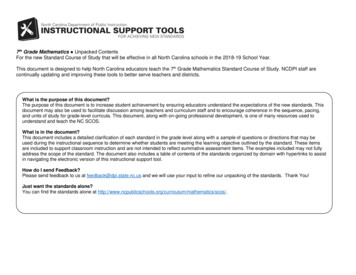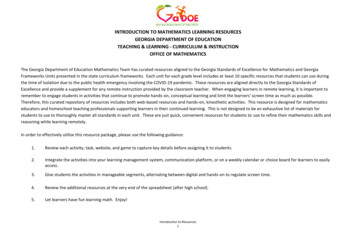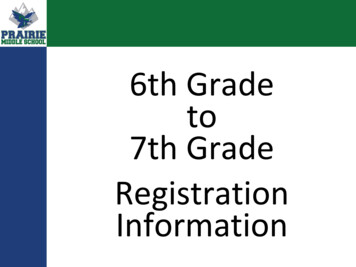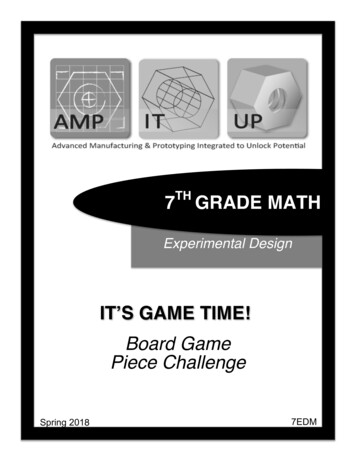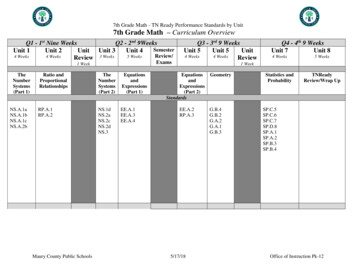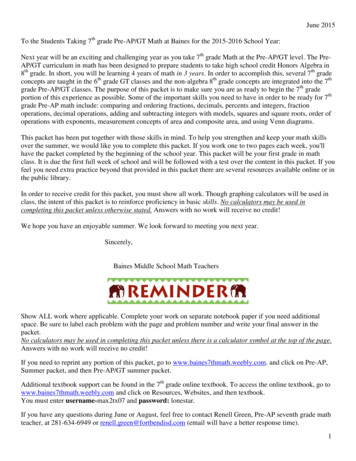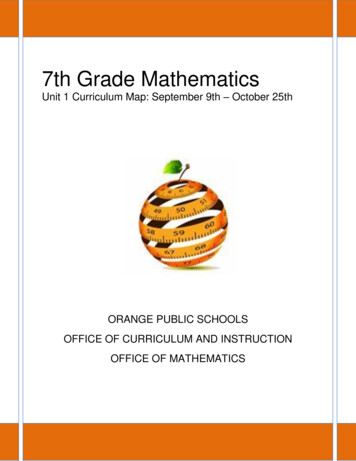
Transcription
7th Grade MathematicsUnit 1 Curriculum Map: September 9th – October 25thORANGE PUBLIC SCHOOLSOFFICE OF CURRICULUM AND INSTRUCTIONOFFICE OF MATHEMATICS
7th Grade Unit 1September 9th – October 25thCommon Core Standards6.NS.5REVIEW OF GRADE 6 FLUENCIESUnderstand that positive and negative numbers are used together to describequantities having opposite directions or values (e.g., temperature above/belowzero, elevation above/below sea level, credits/debits, positive/negative electriccharge); use positive and negative numbers to represent quantities in real-worldcontexts, explaining the meaning of 0 in each situation6.NS.6aRecognize opposite signs of numbers as indicating locations on opposite sides of 0 on the numberline; recognize that the opposite of the opposite of a number is the number itself, e.g., –(–3) 3,and that 0 is its own opposite.6.NS.7cUnderstand the absolute value of a rational number as its distance from 0 on thenumber line; interpret absolute value as magnitude for a positive or negativequantity in a real-world situation. For example, for an account balance of –30dollars, write –30 30 to describe the size of the debt in dollars.1
7th Grade Unit 17.NS.1September 9th – October 25thGRADE 7 NUMBER SENSEApply and extend previous understandings of addition and subtraction to add andsubtract rational numbers; represent addition and subtraction on a horizontal orvertical number line diagram.a. Describe situations in which opposite quantities combine to make 0. Forexample, a hydrogen atom has 0 charge because its two constituents areoppositely charged.b. Understand p q as the number located a distance q from p, in thepositive or negative direction depending on whether q is positive ornegative. Show that a number and its opposite have a sum of 0 (areadditive inverses). Interpret sums of rational numbers by describing realworld contexts.c. Understand subtraction of rational numbers as adding the additive inverse,p – q p (–q). Show that the distance between two rational numbers onthe number line is the absolute value of their difference, and apply thisprinciple in real-world contexts.d. Apply properties of operations as strategies to add and subtract rationalnumbers.7.NS.A.2Apply and extend previous understandings of multiplication and division and offractions to multiply and divide rational numbers.a. Understand that multiplication is extended from fractions to rational numbersby requiring that operations continue to satisfy the properties of operations,particularly the distributive property, leading to products such as (–1)(–1) 1and the rules for multiplying signed numbers. Interpret products of rationalnumbers by describing real-world contexts.b, Understand that integers can be divided, provided that the divisor is notzero, and every quotient of integers (with non-zero divisor) is a rationalnumber. If p and q are integers, then –(p/q) (–p)/q p/(–q). Interpretquotients of rational numbers by describing real-world contexts.c. Apply properties of operations as strategies to multiply and divide rationalnumbers.d. Convert a rational number to a decimal using long division; know that thedecimal form of a rational number terminates in 0s or eventually repeats.7.NS.A.3Solve real-world and mathematical problems involving the four operations withrational numbers.2
7th Grade Unit 1September 9th – October 25thModel Curriculum Student Learning ObjectivesSLODescription1Describe a model, on a horizontal and vertical number line, real-world situations inwhich rational numbers are combined.2Apply the additive inverse property to subtraction problems and develop the argumentthat the distance between two points is the absolute value of the difference betweentheir coordinates.3Explain why a divisor cannot be zero and why division of integers results in a rationalnumber.4Model the multiplication and division of signed numbers using real-world contexts,such as taking multiple steps backwards.5Convert a rational number to a decimal using long division and explain in oral orwritten language why the decimal is either a terminating or repeating decimal.6Apply properties of operations as strategies to add, subtract, multiply, and dividerational numbers.7Solve mathematical and real-world problems involving addition, subtraction,multiplication, and division of rational numbers.3
7th Grade Unit 1September 9th – October 25thConnections to the Mathematical Practices12345678Make sense of problems and persevere in solving them- explain and demonstrate rational number operations by using symbols, visuals,words, and real life contexts- demonstrate perseverance while using a variety of strategies (number lines,manipulatives, drawings, etc.)Reason abstractly and quantitatively- demonstrate quantitative reasoning by representing and solving real worldsituations using visuals, numbers, and symbols- Demonstrate abstract reasoning by translating numerical sentences into realworld situationsConstruct viable arguments and critique the reasoning of others- discuss rules for operations with rational numbers using appropriate terminologyand tools/visuals- apply properties to support their arguments and constructively critique thereasoning of others while supporting their own positionModel with mathematics- model understanding of rational number operations using tools such as algebratiles, counters, visual, and number lines and connect these models to solveproblems involving real-world situationsUse appropriate tools strategically- demonstrate their ability to select and use the most appropriate tool(paper/pencil, manipulatives, and calculators) while solving problems withrational numbersAttend to precision- demonstrate precision by using correct terminology and symbols and labelingunits correctly- use precision in calculation by checking the reasonableness of their answersand making adjustments accordinglyLook for and make use of structure- look for structure in positive and negative rational numbers when they placethem appropriately on the number line- use structure in calculation when considering the position of numbers on thenumber line- Recognize the problem solving structures of word problems and use thisawareness to aid in solvingLook for and express regularity in repeated reasoning- use manipulatives to explore the patterns of operations with rational numbers- use patterns to develop algorithms- use algorithms to solve problems with a variety of problem solving structures4
7th Grade Unit 1September 9th – October 25thVocabularyTermAdditive InverseDefinitionTwo numbers whose sum is 0 are additive inverses of one another.Example: ¾ and ¾ are additive inverse of one another because ¾ (-3/4) (-3/4) ¾ 0MultiplicativeInverseTwo numbers whose product is 1 are multiplicative inverses of one another.Example: ¾ and 4/3 are multiplicative inverses of one another because ¾ 4/3 4/3 * ¾ 1Absolute ValueThe distance between a number and zero on the number line. The symbolfor absolute value is shown in this equation IntegersA number expressible in the form a or –a for some whole number a. The setof whole numbers and their opposites { , -3, -2, -1, 0, 1, 2, 3 }Long DivisionStandard procedure suitable for dividing simple or complex multi-digitnumbers. It breaks down a division problem into a series of easier steps.NaturalNumbersThe set of numbers {1, 2, 3, 4, }. Natural numbers are also called countingnumbersNegativeNumbersThe set of numbers less than zeroOppositeNumbersTwo different numbers that have the same absolute value. Example: 4 and 4 are opposite numbers because both have an absolute value of 4PositiveNumbersThe set of numbers greater than zero.RationalNumbersThe set of numbers that can be written in the form a/b where a and b areintegers and b 0.RepeatingDecimalA decimal number in which a digit or group of digits repeats without end.TerminatingDecimalA decimal number that contains a finite number of digitsZero PairPair of numbers whose sum is zero5
7th Grade Unit 1September 9th – October 25thPotential Student Misconceptions When subtracting numbers with positive and negative values, students often subtract thetwo numbers and use the sign of the larger number in their answer rather than realizethey are actually moving up or down the number line depending on the signs of thenumbers. They also become very confused when subtracting a negative and often addthe numbers and make the answer negative or subtract the numbers and make theanswer negative. Another common mistake occurs when students attempt to apply the rules for multiplyingand dividing numbers to adding and subtracting. For example, if they are subtractingtwo negative numbers they subtract the numbers and make the answer positive.Similarly, when subtracting a negative and positive value, they subtract the two numbersmake the answer negative. Students will frequently forget the direction to move when adding on a number line. It isadvisable to start with smaller numbers that they are familiar with before giving problemswith larger numbers or with fractions, or decimals. When interpreting a negative mixed number, the students frequently assume that thewhole number part is negative and the fraction part is positive instead of considering thewhole mixed number as negative, both the whole number and the fraction partJust as students are taught that 23 means 20 3, and that 2 ¾ means 2 ¾, teachersshould explicitly explain what -2 ¾ means. They should lead the students to understandthat it means (-2 -3/4) and not (-2 ¾). Students often make the mistake of assuming that signed numbers mean only integers.They should be exposed to exercises that include signed fractions and decimals to curbthis mistake. When dealing with addition and subtraction rules, students often make the mistake ofchanging the sign of the first number instead of leaving it as it is and then changing thesubtraction sign and changing the second number to its additive inverse. Studentsshould spend more time working on addition and subtraction using the number line sothat they may have a strong foundation and understanding of the reason that subtractionchanges to addition and the second number is changed to its additive inverse6
7th Grade Unit 1September 9th – October 25thTeaching Multiple RepresentationsCONCRETE REPRESENTATIONS 2-color coin counters to representnegatives and positives Number Lines Thermometers and other equallypartitioned tools Rectangular StripsPICTORIAL REPRESENTATIONS Number Lines (Horizontal) Number Lines (Vertical) Bar/Fraction Models7
7th Grade Unit 1 100’s Grid Distance / Vector ModelSeptember 9th – October 25thAdding IntegersAddition is modeled as putting a secondvector’s tail at the first vector’s head andfinding where the second vector’s headextends to.3 -4 -1Subtracting IntegersSubtraction can be thought of as comparingthe two vectors p, and q, by putting both tailstogether (starting each from zero) andasking the question: “How would one extenda vector from the head of p to the head ofq?” The length and direction of that vectorwould be the result of the subtraction.3 - -4 7 ABSTRACT REPRESENTATIONSApplying Properties of Numbers; p – q p (-q); p - -q p q Applying Properties of NumbersApplying the standard algorithms for addition, subtraction, multiplication, and divisionSymbolic Representations8
7th Grade Unit 1September 9th – October 25thPacing GuideActivityReview of 6th GradeCommon CoreStandards/SLO6.NS.5; 6.NS.6a; 6.NS.7cEstimated Time7 daysAccentuate the Negative(CMP3) Investigation 17.NS.A.1; 7.NS.A.1a;7.NS.A.2; 7.NS.A.3;7.EE.B.4bSLO 1, 2, 73 daysAccentuate the Negative(CMP3)Investigation 27.NS.A.1; 7.NS.A.1b;7.NS.A.1c; 7.NS.A.2;7.NS.A.3SLO 1, 2, 6, 73 daysAccentuate the Negative(CMP3) Investigation 37.NS.A.2; 7.NS.A.2a;7.NS.A.2b; 7.NS.A.2c;7.NS.A.3SLO 3, 4, 5, 6, 73 daysAccentuate the Negative(CMP3) Investigation 47.NS.A.1; 7.NS.A.1d;7.NS.A.2; 7.NS.A.2a;7.NS.A.2d; 7.NS.A.3SLO 1, 4, 6, 73 daysAssessment Check 17.NS.11 dayStretching and Shrinking(CMP3) Investigation 17.RP.A.2; 7.RP.A.2a; 7.G.A.1SLO 72 daysStretching and Shrinking(CMP3) Investigation 27.RP.A.2; 7.RP.A.2a;7.RP.A.2b; 7.G.A.1SLO 72 daysStretching and Shrinking(CMP3) Investigation 37.RP.A.2; 7.RP.A.2b;7.RP.A.3; 7.G.A.1; 7.G.A.2SLO 73 daysStretching and Shrinking(CMP3) Investigation 47.RP.A.2; 7.RP.A.2a;7.EE.B.4; 7.NS.A.3; 7.G.1SLO 73 daysAssessment Check 27.NS.2; 7.NS.31 dayUnit Review/Task/Project7.NS.1; 7.NS.2; 7.NS.32 daysUnit 1 Assessment7.NS.1; 7.NS.2; 7.NS.31-2 days (October 24/25)9
7th Grade Unit 1September 9th – October 25thAssessment ChecksAssessment Check 11. What temperature would be 15 more than the temperature shown on the thermometerbelow?2. Determine the number indicated on the number line below.013. Jim’s cell phone bill is automatically deducting 32 from his bank account every month.How much will the deductions total for the year?a.b.c.d.-32-44-364-3844. A submarine was situated 450 feet below sea level. If it descends 300 feet, what is itsnew position?5. In the Sahara Desert one day it was 136 F. In the Gobi Desert a temperature of -50 Fwas recorded. What is the difference between these two temperatures?6. Mario walked mile to school and he walked back home. Then he walked miles to thestore and back home. How far did Mario walk altogether?10
7th Grade Unit 1September 9th – October 25thAssessment Check 21. Let -6, find the value of the following expressions:5 -5 5 (- )5 2. When a diver is underwater, he is breathing air at a higher pressure than usual. If hestays too deep for too long, the high pressure of the air causes some of it to dissolve inhis blood. Then, if he ascends too quickly, the air will “un-dissolve” and make bubbles inhis blood, a very painful experience called “the bends.” The US Navy has establishedtime limits for how long a diver can stay at certain depths before he is in danger of theBends.To determine the amount of time (in seconds) a diver can safely remain under water, we usethe equation:Time -6.1 depth 750If a diver is at a depth of 120 feet, how long can he safely remain under water before he is indanger of the Bends?3. A speedboat can travel at a rate of 40 miles per hour. At this rate, what is the distancethat the speedboat will travel in 6 minutes?4. A bottle contains 0.375 liters of juice. Which of the following is another way to express0.375?a.b.c.d.3/753/837/503/411
7th Grade Unit 1September 9th – October 25thExtensionsOnline andards/k8- Performance tasks, scoring guideshttp://www.ixl.com/math/grade-7- Interactive, visually appealing fluency practice site that is objective etic/absolute-value- Interactive, tracks student points, objective descriptive videos, allows for ecimals/decimal to fraction/e/converting fractions to decimals- Interactive, tracks student points, objective descriptive videos, allows for h Grade 7.pdf- Common Core aligned assessment questions, including Next Generation AssessmentPrototypes12
7th Grade Unit 1September 9th – October 25thAssessment Resources7.NS.1 Summative TaskReplace each blank square in the bubble chart with a rational number or symbol that makeseach number sentence true.13
7th Grade Unit 1September 9th – October 25th7.NS.2a-b Summative TaskFORENSIC SCIENCEWhen a skeleton is found, a forensic scientist uses the lengths of certain bones to calculate theheight of the living person. The bones that are used are the femur (F), the tibia (T), thehumerus (H), and the radius (R). When the length of one of these bones is known, one of thefollowing formulas is used to determine the height. All measurements are in inches. Find theapproximate height of a female skeleton that has a humerus that measures 12inches.MALEFEMALEHeight 2.2 F 27Height 2.3 F 24Height 2.4 T 32Height 2.5 T 29Height 3 H 29Height 3.1 H 26Height 3.7 R 32Height 3.9 R 29TEMPERATURETo convert between degrees Celsius (C) to degrees Fahrenheit (F), we use the equation F 9/5(C 32). Calculate the temperature in Fahrenheit given C -7 .7.NS.2c-d Summative TaskAiden needs to buy food for his dog Dusty. The Pet Emporium (TPE) has a 30-lb bag of Dusty’sfavorite brand on sale for 19.95, while Woofs’R’Us (WRU) has a 40-lb bag of Dusty’s favoritebrand on sale for 24.95. Which food package should Aiden buy if he wants to get the better deal on Dusty’sfavorite brand? How much would his savings be if he purchased 3 bags of the less expensive brand?14
7th Grade Unit 1 thSeptember 9th - October 25 2 GRADE 7 NUMBER SENSE 7.NS.1 Apply and extend previous understandings of addition and subtraction to add and subtract rational numbers; represent addition and subtraction on a horizontal or vertical number line diagram. a. Describe situations in which opposite quantities combine to make 0. For
